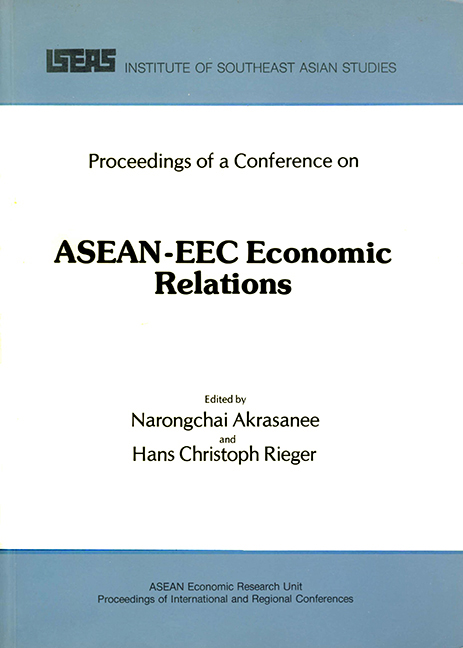Book contents
- Frontmatter
- Contents
- FOREWORD
- BUILDING BRIDGES AND OPENING DOORS
- 1 TRADE
- ASEAN-EC Trade Relations: An Overview
- Trends of EC Protection and the Prospects of ASEAN Trade
- Issues Relating to the EC's Imports of ASEAN Primary Products
- ASEAN Manufactured Exports in the EC Markets: An Empirical Assessment of Common and National Tariff and Non-Tariff Barriers Confronting Them
- A Constant-Market-Shares Analysis of ASEAN Manufactured Exports to the EC
- II INVESTMENT
- APPENDICES
Trends of EC Protection and the Prospects of ASEAN Trade
from 1 - TRADE
Published online by Cambridge University Press: 21 October 2015
- Frontmatter
- Contents
- FOREWORD
- BUILDING BRIDGES AND OPENING DOORS
- 1 TRADE
- ASEAN-EC Trade Relations: An Overview
- Trends of EC Protection and the Prospects of ASEAN Trade
- Issues Relating to the EC's Imports of ASEAN Primary Products
- ASEAN Manufactured Exports in the EC Markets: An Empirical Assessment of Common and National Tariff and Non-Tariff Barriers Confronting Them
- A Constant-Market-Shares Analysis of ASEAN Manufactured Exports to the EC
- II INVESTMENT
- APPENDICES
Summary
The aim of this paper is to provide an overview of EC protection, its problems and possible future evolution, from the point of view of developing countries, particularly the members of ASEAN. The EC is one of ASEAN's chief markets, accounting for 14.1 per cent of ASEAN's exports in 1979, and 13.7 per cent of its imports. In developing countries there is some concern that the markets of developed countries might in future become more protected. Is there a risk of this happening in the EC?
The paper is organized as follows. The first part describes the mechanism of EC decision-making, the EC's control of the instruments of trade policy, and its attempt to meet developing countries' demands for “special and differential treatment”. The second part describes the systems which have evolved for the protection of a number of sectors which are, or may become, important to ASEAN. The last section draws together the conclusions of the analysis.
EC DECISION-MAKING AND THE COMMON COMMERCIAL POLICY
Decision-making in Brussels
As is well known, the European Community is unique among international institutions because of the “supra national” powers with which it was endowed by the treaties which established it. One must however resist the temptation of thinking of the European Community as a more autonomous decision-maker than it really is. The roots of Brussels decisions are very much to be found in the capitals of the member states.
To carry out its mission of organizing the Common Market, the EC issues directives and regulations which are a source of law, and to which national legislations must conform. The Community may carry out international negotiations and conclude agreements and treaties. The Luxembourg Court, which judges disputes between the Community, the member states, and the citizens of those states, has played a major role in consolidating and extending the authority of the Community. A democratically elected parliament has the power to reject the Community budget and to revoke the Commission.
- Type
- Chapter
- Information
- ASEAN-EEC Economic Relations , pp. 52 - 91Publisher: ISEAS–Yusof Ishak InstitutePrint publication year: 1981



